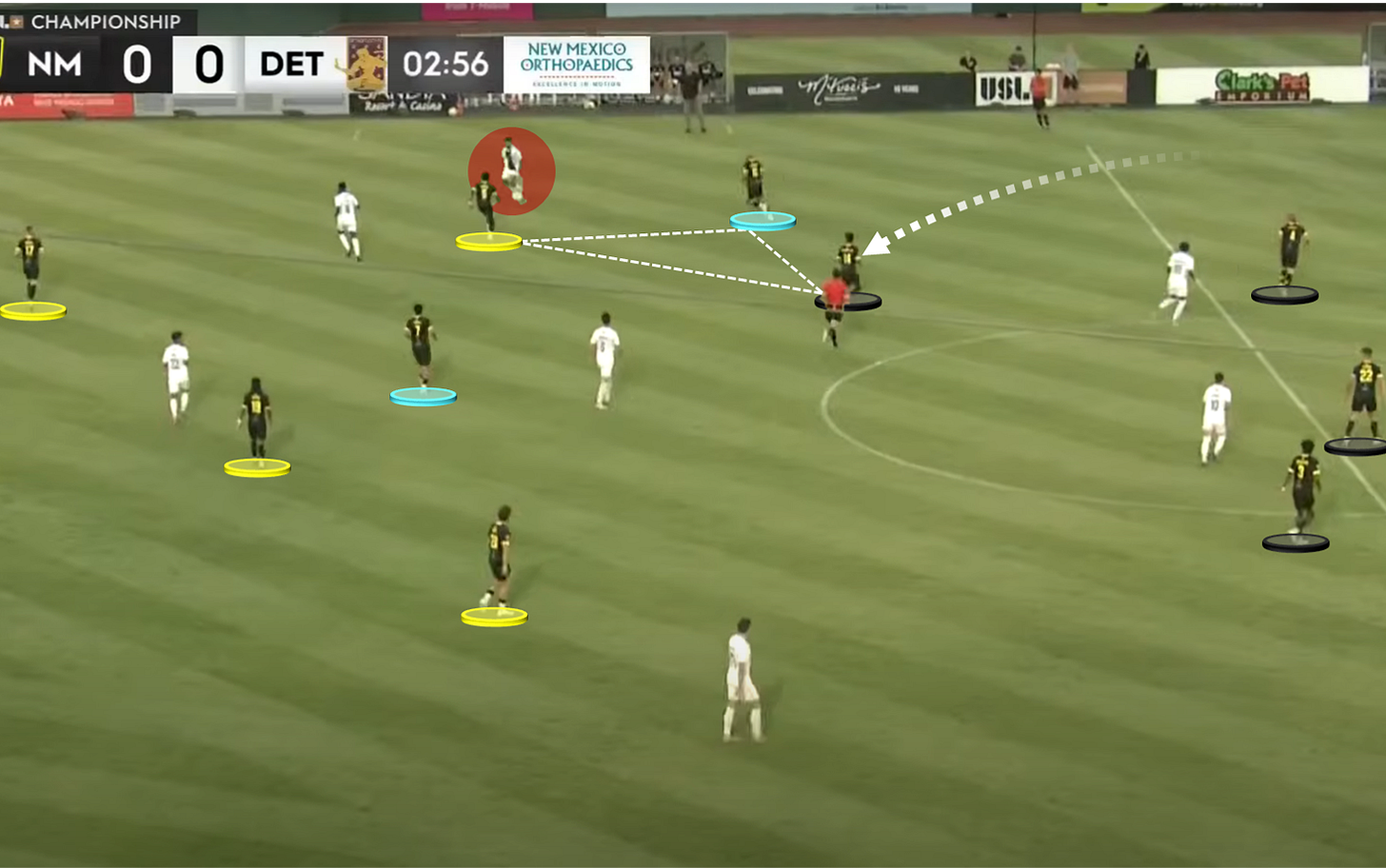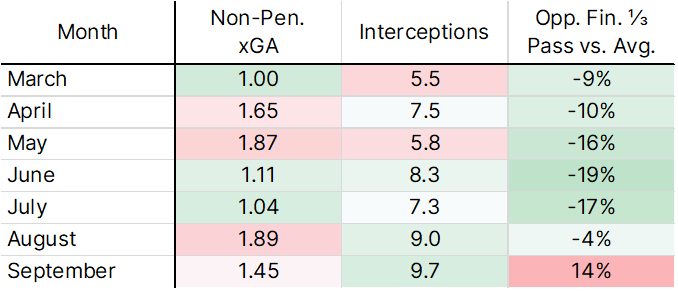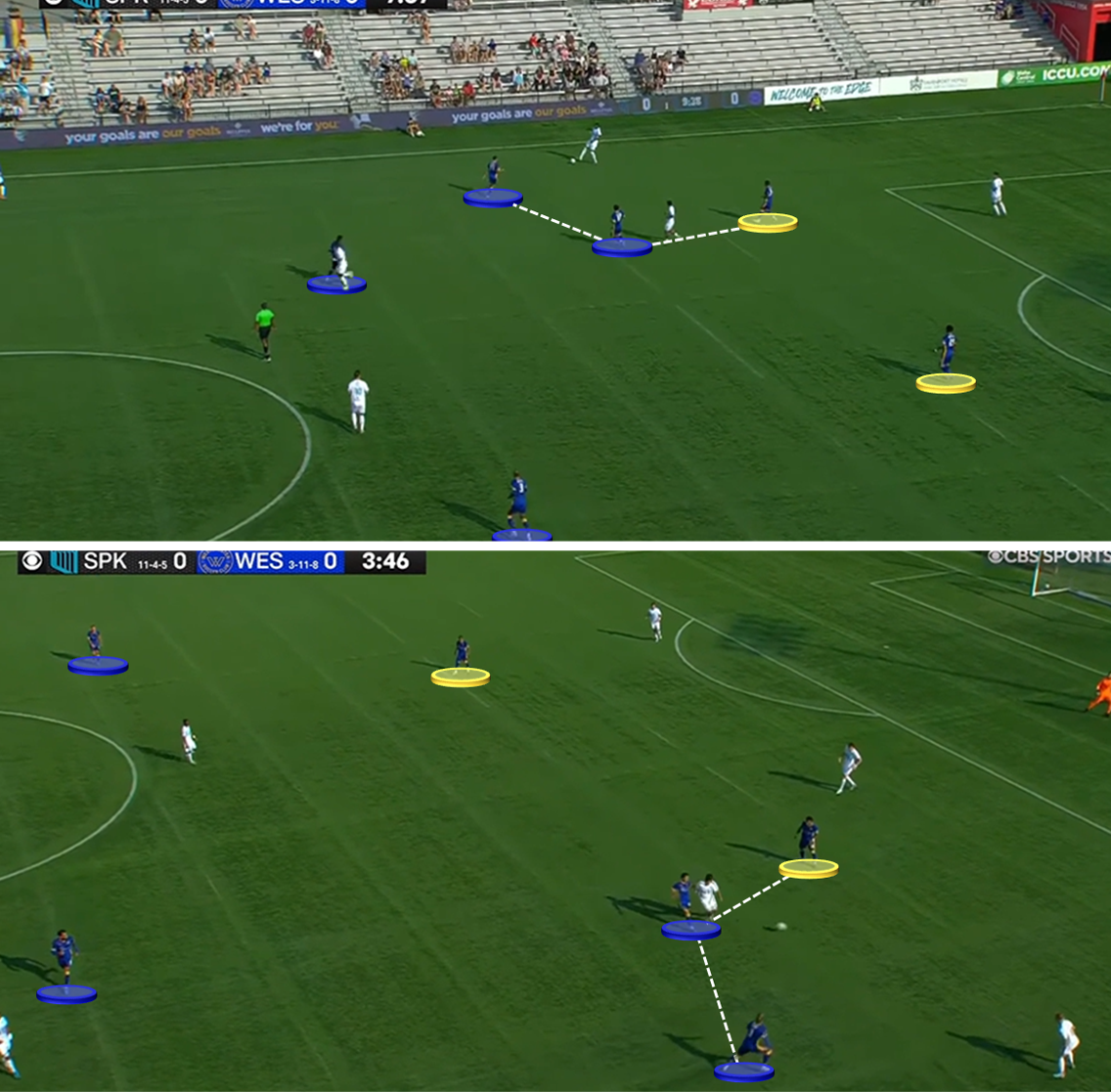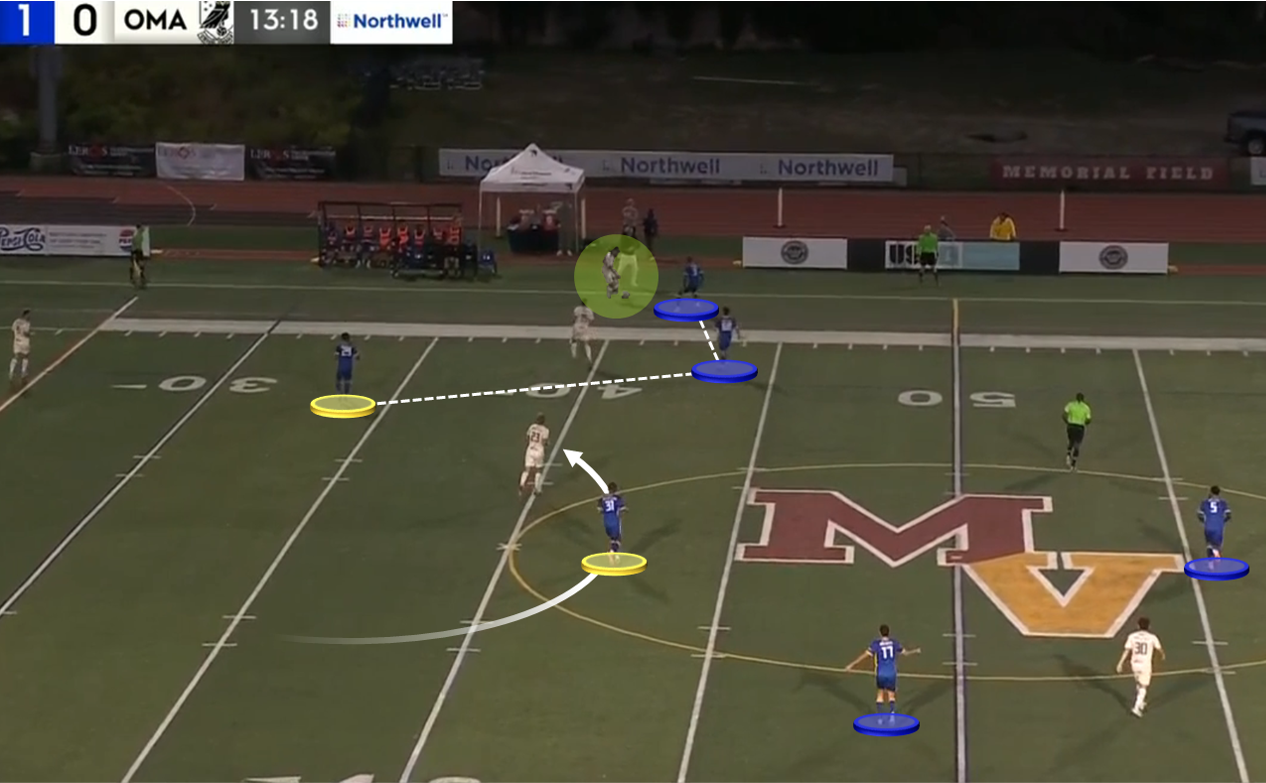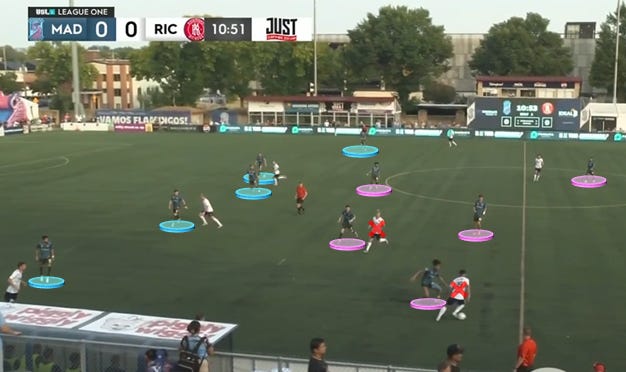The Back Four: New New Mexico?
Featuring New Mexico’s defense, the Henny Derby, and more USL miscellany
Welcome in to The Back Four!
As always, check out Backheeled for more USL content, including this week’s Open Cup recap. Also, check out This League! for an audiovisual dive into the week that was.
Without further ado, let’s get to it.
The new New Mexico
New Mexico United is adapting. Despite dropping Saturday’s match against FC Tulsa in dramatic fashion, this team made significant progress in Week 28, showing a comfort level in defense that we arguably hadn’t seen at any point across 2025.
In a clean sheet victory on Wednesday, opposing Detroit mustered just 0.61 xG. Four days later, Tulsa only got to 0.46 xG. Those terrific returns owe to the structure that Dennis Sanchez has put into place and the adaptation he’s made to his typical tactical style.
In every match since August 10th, United’s goalkeepers have played double-digit long passes; they did so just six times in the preceding 16 games. As a result, New Mexico has been able to keep danger out of their own area, having been forced to make roughly 15% less interventions in their third. Notably, New Mexico did terribly in duels against Detroit and Tulsa, winning just 48 of 124 non-aerial battles. Still, tilting the pitch and trusting the structure paid dividends.
This moment comes immediately after a New Mexico turnover as opposing Detroit finds a wingback. That player immediately faces heat from winger Dayonn Harris and central midfielder Carlos Moguel. Fearing that said ball pressure isn’t enough to deny the central spaces, Will Seymore takes an intelligent step from right back to cover a potential gap – three players all deny progression!
New Mexico bases their press out of a 4-2-4, but they’re willing to get fluid within that shape. Zico Bailey and Valentin Noel regularly interchange between the left wing and No. 10 spots, and that held true against Tulsa over the weekend. Here, you’re seeing the pivot get frisky, but they’re typically supportive.
Because of moments like this, United limited Detroit’s ability to access the central areas. Le Rouge’s wingbacks completed just three passes into the all-important Kobe Hernandez-Foster at the No. 8 spot. Even though they led for 82 minutes and had the luxury to sit back, New Mexico still ended up with more final-third passes than their guests.
The same level of dominance didn’t recur against Tulsa, but United never got caught out. This was another match where Sanchez’s side got obliterated in the duel category; the visitors also won 54% of the game’s recoveries. Still, a keen structure on restarts prevented Tulsa from flexing their usual muscle in transition.
Above, New Mexico restarts long via goalkeeper Kris Shakes. Rather than sit in a flat 4-4-2, United shifts their formation to suit the second-ball situation. The fullbacks step up a line; the center mids split. You’d probably call it a 2-3-4-1, and the focus is on a six-man core up the middle.
After a few headers, Tulsa comes up with possession in a one-on-one against Chris Gloster. Still, that initial choice to elevate the fullbacks means that Gloster is immediately putting a body on the ball carrier. The guests have to slow down, allowing Talen Maples to pick up the opposing No. 9 as the rest of the defense recovers into a 4-4-2ish shell.
Sequences like this were commonplace. New Mexico’s considerate shape slowed Tulsa down, but it also allowed for effective attacking transitions. If you go back to that clip above, you’ll notice something funny about the restart formation: Dayonn Harris, the right winger, isn’t on screen in the still.
Harris is this club’s truest wide threat, a player full of speed and verve. He spaces to the right wing in the clip to stretch the defense – and potentially receive if United regains. Harris, who attempted seven crosses in just 58 minutes against Tulsa, is the free-wheeling sort of presence that New Mexico has often lacked this year.
Dennis Sanchez has this team looking a lot different than the short passing-obsessed team we saw at the beginning of the season, but the pragmatism is well-suited to the Western Conference in 2025. We’ll see if it sticks, but New Mexico seems to have found their long-awaited defensive answer.
Varied Hadji Barry
Hadji Barry scores goals. That’s what he’s known for, that’s what won him a Golden Boot, and that’s why he got a big-money move to Egypt.
Hadji Barry is also a very, very good creator who understands how to bring his teammates into a match. Last weekend against Monterey, Hartford’s new star completed a plurality of his passes to center back Jordan Belluz after receiving in the right halfspace; he only took one touch in the box, airmailing a close-range shot off a corner. Still, when push came to shove, Barry’s broader ability to influence the game was paramount to Hartford’s winning effort.
You’re not going to see the superstar No. 9 take a touch here, and that’s okay. Hartford is in full 3-1-4-2 mode, a noticeable shift as compared to the 3-1-5-1 attacking shape that’s typically prevailed over the last few months.
Left winger Jonathan Jimenez carries the ball upfield with Barry, fellow striker Adewole Obalola, and wingback Owen Presthus ahead of him. Their movement stretches the opposition, allowing Jimenez to get into a one-on-one that he uses to maximal effect.
By the time Jimenez can look for teammates, something fascinating has happened. Barry has made a hard cut toward the left, drawing the eyes of an opposing center back in the process. Seeing that run develop, winger Jack Panayotou advances into the space Barry once inhibited to find a shot.
Describing this as a legitimate formation change is probably too bold, but Hartford used high-low variety between Barry and Obalola to constantly stress Monterey. Meanwhile, the narrow wingers – call them No. 8s if you want – relished the space the forwards provided.
The run you saw above is pretty classic striker stuff. Here, though, Barry takes his turn as the primary creator. This is more of a transitional moment, but the same ideas are at play: #92’s gravity demands defensive attention, and Panayotou thinks multiple steps ahead to complement that fact.
When Barry receives, he creates just enough of a pause in the opposing center back to give Panayotou space. Upon receiving, the New England loanee knows that he can cut back against the recovering Monterey defender’s momentum and find his left foot. A goal ensues.
Though Barry came off at halftime, it’s already clear how he changes the game for Hartford. The striker has a plug-and-play versatility that can make any of his teammates more imposing.
Hartford’s biggest problem is figuring out how to fit all their star attackers into one lineup; Michee Ngalina only played 27 minutes over the weekend, and Kyle Edwards – Barry’s replacement – got a brace off the bench. That’s a very, very good problem to have for a team that feels like a legitimate title contender.
Westchester check-up
Westchester is almost certainly not going to make the playoffs, but they’re not resting on their laurels. Between the additions of goalkeeper Enrique Facusse and forward Deshane Beckford, WSC made waves. More notable than any personnel change is the way that Westchester’s defense has continued to evolve.
After dabbling with a back three, Dave Carton has returned to a 4-4-2 baseline in recent weeks and months. That shape is the out-of-possession baseline for most clubs in the USL, but it’s Westchester’s specific iteration that’s producing somewhat odd returns.
For most of 2025, Westchester did well to limit opponents’ access to the final third, and that showed up in the numbers. Above, you’re seeing the club’s xG allowed, interceptions, and relative final-third pass allowances.
The first two columns are self-explanatory. That latter category is measured on a team-by-team basis relative to season-long averages. Last weekend, for instance, Westchester allowed Union Omaha to play 108 passes in the final third. That’s 27% higher than Omaha’s season-long mean.
Higher numbers are a bad thing. You’re letting your opponents hover around the 18-yard box more often than usual. Still, there’s some noise in the data. This WSC team has spent long stretches of time trailing, meaning that the opposition has little impetus to push forward and attack full-bore.
So far in September, WSC has consistently allowed their opponents to dwell in the final third. Once there, rival attacks have found it too easy to create chances; see a 1.45 xGA average this month.
The uptick in interceptions adds a wrinkle. In a Sunday night match against Spokane two weeks back, Westchester adopted a diamond-shaped midfield press that did well to tilt the pitch. At best, the formation forced bad passes that Westchester could intercept and turn into transition chances. Still, it wasn’t a panacea; once the first line of the 4-4-2 diamond was beaten, the decision was to bunker deep, and underlying back-line issues came to bear.
Let’s focus on that high press. You see two screenshots from the first half of that Velocity match here, with the diamond in full effect. In each case, Taimu Okiyoshi steps up like a No. 10 while Joel Johnson holds as a No. 6.
By matching Spokane’s two center backs with two pressing strikers and marking their primary holding mid via Okiyoshi, Westchester tried to funnel play toward the sidelines. If the hosts moved wide, Okiyoshi and the ball-side winger would rotate to follow the pass. That happens in each case above, with a three-man trap denying Spokane the ability to advance.
Westchester ultimately held the Velocity under 1.0 xG largely because they could disrupt their rhythm in situations like these. Still, there were too many passive moments in mid-low block that counteracted the press. I talked about the 15 minutes post-halftime in this match last week, a stretch where Spokane put on a passing clinic until they found their winning goal.
What changed this past weekend against Union Omaha? Not a whole lot! Omaha was more willing than Spokane to play over the top, completing 48% more long passes against WSC than the Velocity did. At the same time, the diamond still prevailed in the high press.
You’re getting another taste of the shape here, with Omaha pinned at the sideline. Crucially, Beckford – the off-ball striker – rotates low to help address the double pivot, shadowing the No. 6 that isn’t already enmeshed in the sideline trap.
If moments like these were productive, Westchester still lacked discipline in low block. A flip switched after the guest passed the halfway line, and WSC became far less aggressive in closing down.
When Omaha equalized in the 15th minute, neither JC Obregon nor Beckford pressed the ball carrier as Los Buhós played across the midfield. As such, the guests were able to create a wide one-on-one, serve in a cross, and expose Samory Powder and Andrew Jean-Baptiste at the far post.
A similar far-post dilemma – left instead of right this time – gave Omaha their winner in first-half added time. Josh Drack failed to clear, Bobby Pierre got caught in a rebound situation, and Westchester found themselves permanently down 2-1.
Westchester is finding their footing in the press and learning how to get aggressive, but they’re vulnerable in their own block. Intensity can’t just be a one-phase thing; when you allow opponents to dwell in your defensive third, you’re going to invite trouble.
Dave Carton is halfway there without possession, but his defense is too passive. It’s hard to know whether that’s an issue of approach or personnel. A season-long onslaught of defensive mistakes points to the latter explanation, but no matter where you land, Westchester’s close-but-no-cigar defensive scheme is the reason they’ve struggled across 2025.
Derby developments
Richmond has been a back-three team since the end of August, but the fit between system and roster has been tenuous. The Kickers downed Knoxville in their first match after returning to the 3-4-3 thanks to a corner kick goal; they beat Westchester at the start of this month thanks to a phenomenal goalkeeping howler. Last Saturday, Forward Madison laid bare the issues innate to the new-ish approach.
Matt Glaeser understood a fundamental contradiction about the Kickers: they’re easily encouraged to play long, but they’re bad in the air and spotty in second-ball situations. Indeed, Richmond’s aerial win rate (45%) and number of recoveries per game (39.9) are both bottom-four marks in League One.
Madison never played outside of themselves. When the Kickers restarted long, the hosts trusted John Murphy and the midfield to come good in a compact 5-1-2-2 structure. As a result, the center backs rarely had to overextend.
When Richmond tried to reset possession, Madison’s high press emerged with man-centric aggression centered on the opposing back three. The ‘Mingos took what they were given, winning 60% of aerial duels and allowing just eight touches in their own box.
Crucially, Madison knew how to turn defense into offense, and many of their best chances came from quick moves in the first few seconds after a ball recovery. Here, they let Murphy win the initial header, continue to battle until they’ve found control, and then look upfield posthaste.
When forward Dean Boltz – a veritable ball of energy over the weekend, full of smart side-to-side movement in zone 14 – drops to contest the initial header, he’s replaced by Aiden Mesias making a vertical run out of the midfield. Likewise, Lucca Dourado waits for his moment to burst forward at the striker spot. You can feel Madison walking the tightrope, but they find the exact moment to push numbers forward against Richmond’s vulnerable defense.
This half-chance, ultimately swept away by goalkeeper James Sneddon, is a good representation of how Madison tested the Kickers’ high-ish back line. That defensive positioning was a natural result of the direct system – you need to push your defense high if your restarts are long! – but it made transitions particularly harrowing. Just as Prince Saydee (five dribbles, seven crosses) tested this team in transition in the Westchester game, Madison had a particularly good time breaking against the Kickers’ left side.
Chris Garcia’s numbers from the wingback spot weren’t as impressive as Saydee’s, but he tended to mix under- and overlapping movement in a manner that challenged the pairing of 20-year-old Beckett Howell and 19-year-old Griffin Garnett up that side. Meanwhile, the construction of the Richmond midfield meant that help from the pivot didn’t always arrive.
The Kickers seamlessly blended 3-5-2 and 3-4-3 tenets depending on where Darwin Espinal camped himself, but Nils Seufert also took on fairly significant possessive responsibilities in the midfield. The problem? Those two only completed a single pass into the box and often lagged in terms of their defensive help.
Of course, Madison set themselves up to limit the impact Espinal and Seufert could make creatively. Richmond’s best moves in recent weeks have centered around Espinal’s ability to find pockets in the halfspace against defenses distracted by overlapping wingback movement. Likewise, Seufert’s ability to switch play toward Simon Fitch on the right or to slip in subtler passes between lines had made the German particularly threatening.
Madison didn’t let it happen, as in the mid-block moment above. The back five is evenly spaced and holding a space-limiting height; the pivot clogs useful central space, and Murphy is hyper-aware of Seufert (marked with an “X”) on the move. Meanwhile, Mesias has dropped in on the weak side to allow fellow midfielder Isaac Angking (part of the pink-coded front five) to chase Espinal as soon as he receives.
This is Madison at their organized best and Richmond at their least coherent. In a game where the hosts ran up a 2.0 to 0.6 xG margin, similar moments were commonplace.
For the Kickers, it’s yet another letdown in a season where momentum has been scant. Darren Sawatzky hasn’t hesitated to make changes, but they’ve rarely panned out for more than two or three weeks at a time. This team’s playoff hopes aren’t done yet, but the inability to balance all the offensive talent with a sense of control continues to frustrate.
For Madison, getting a clean sheet is an accomplishment in its own right, particularly in a rivalry game. This club had allowed seven goals in their preceding two matches, so Glaeser’s ability to balance structure with offensive explosiveness shone bright. It might not be enough to chase down the #8 seed, but it’s something that the 5,000 fans that packed Breese Stevens Field ought to savor.
While we’re here…did Richmond improve in the Portland game on Wednesday?
Kinda? The Kickers did far better to break lines with controlled verticality, leaning to the possibility of three-on-two advantages over the Hearts of Pine pivot. Where Madison was allowed to settle, Portland found themselves challenged at a rain-soaked City Stadium.
At the same time, I’m being generous when the route to a goal was “let Darwin Espinal cook.” Richmond played into pressure and got in their own way defensively. They actually won a 54% majority of duels but couldn’t maintain enough structure to deny Portland. Once again, the Kickers’ opposition picked up 2.0 non-penalty xG. That’s bad, no two ways about it.
Fort Lauderdale’s ramp-up
Tyrone Mears, a classic “remember that guy” from the lower reaches of the Premier League and his late-career MLS stun, turned Fort Lauderdale United into a contender from the jump in the Super League’s inaugural season. Fort Lauderdale only qualified for the postseason on a fourth-seed tiebreaker, but they reached the title game and nearly came away winners against in-state rival Tampa Bay.
United lost numerous key players over the offseason. Star forward Addie McCain (9.9 xG+xA) was poached by Lexington; ditto for midfielder Tatiana Fung. Fullback Sabrina McNeil joined the Sun, and the ever-progressive Felicia Knox – one of just eight players with at least 2.7 xA and 130 final-third entry passes – ended up in Spokane. Now, Mears is stepping up to become his organization’s president of soccer ahead of the launch of this club’s League One team in 2026.
It all looks a bit different in South Florida, but new manager Ali Rogers is still inheriting a team with firepower. Fort Lauderdale very clearly has the juice after pouncing on previously undefeated Dallas last Saturday.
Nowhere is the quality clearer than on the right flank, where Sh’nia Gordon and Kelli van Treeck are lighting up the wing. Gordon, who starred as an out-and-out winger in 2024, has shifted to the right back spot to accommodate her new partner. Van Treeck, meanwhile, joined the club after graduating from Lipscomb in 2023 with 25 goals in 36 appearances – her scoring chops are undeniable.
In what proved to be Mears’ last match on the sideline, Fort Lauderdale took the fight to Dallas. Trinity want to defend in a 4-4-2ish concept before bending into a back three with the ball, and United used their wide spark and a well-conceived press to stop that from happening.
Above, you see Fort Lauderdale essentially adopt a 4-2-3-1. This was a match where their midfield was fairly malleable; up the middle, Stella Nyamekye blended No. 10 and No. 8 roles ahead of a Darya Rajaee/Lily Nabet pivot. In this case, that trio’s ability to mark Dallas up the middle helps force a turnover into Jasmine Hamid’s feet.
Hamid, a left winger, combined with Gordon to attempt 87 dribbles last year. Her ability to move with the ball is hugely gravitational. As Hamid cuts right, she draws the Trinity defense and thus frees an overlap from the right back. Meanwhile, Van Treeck slinks in and cuts to the far side of the primary No. 9.
While Gordon’s cross doesn’t ultimately connect, this sequence is highly indicative of how Fort Lauderdale got at Dallas. A 16th minute goal from Van Treeck started with a Hamid takeaway in the press; another chance in the 28th minute started the same way.
Fort Lauderdale consistently brought a verticality to the table that helped them cause trouble. When Nyamekye dropped in, United automatically generated a three-on-two in the midfield. Whoever went unmarked – often Rajaee – thus had space to hit a bright pass over the top. That method furnished Van Treeck, who finished Saturday with a brace on six shots, with a left-footed cutback chance in the 28th minute.
In other words, United consistently found ways to overload Dallas up the middle and catch them out with combination play in transitional moments. This might be a team in the midst of a reshuffle, but in Gordon, Van Treeck, and a stellar midfield, Fort Lauderdale’s got the core of a team that’s built to succeed in the Super League.
Quick Hits
In other news this week…
Tommy McNamara is killing the game in Las Vegas. I don’t know if I expected him to look this technical at the Championship level from the jump, but he’s giving the Lights a ton in the pivot. The 34-year-old hit on 94% of his passes last weekend but also showed an astute sense for pushing forward and creating in more elevated positions, all while snuffing out Miami’s counter. I’m so curious to see the extent of his role – if any – heading into 2026 under Devin Rensing.
In a similar vein, Johnny Klein has been stellar for a Monterey team that’s entirely too reliant on him and Grant Robinson to bear their creative burden. Per the inimitable USLStat account on Bluesky, Monterey’s last two matches have, respectively, seen 52% and 45% of final-third passes come up the left. It’s great that Klein and Robinson are dominating that flank no matter the formation or opponent, but it’s bad that no one else is picking up the slack.
With Robert Redford passing on this week, I took the chance to watch All the President’s Men, which was one of my weird movie blind spots. Turns out the first amendment is pretty important, folks!
In any event, Dustin Hoffman’s pesky rodent energy playing off of the eminently suave Redford is immaculate. Most of the newsroom scenes are shot with a split diopter, deep/shallow focus thing that’s odd but completely transfixing? We used to make creative decisions in this country.

